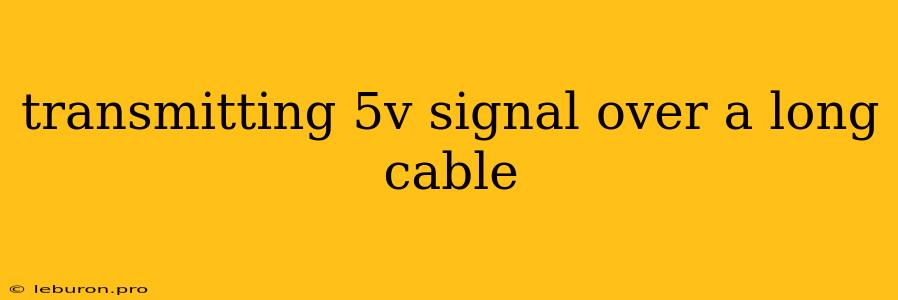Transmitting a 5V signal over a long cable can be a challenging task due to signal degradation and potential interference. The longer the cable, the more susceptible the signal is to attenuation, noise, and reflections. This article delves into the challenges of transmitting a 5V signal over long distances and explores various techniques to overcome these obstacles. We will examine the key factors influencing signal integrity and explore practical solutions for reliable transmission.
Understanding Signal Degradation
Signal degradation refers to the deterioration of a signal's quality as it travels through a cable. This degradation occurs primarily due to the following factors:
1. Attenuation: The loss of signal strength as it propagates through the cable. This loss is dependent on the cable type, its length, and the frequency of the signal. Longer cables and higher frequencies experience more attenuation.
2. Noise: External sources of interference that can corrupt the signal. This interference can come from electromagnetic fields, power lines, or other electronic devices.
3. Reflections: Occur when the signal encounters impedance mismatches at the source, load, or cable connectors. These mismatches cause portions of the signal to bounce back, potentially interfering with the original signal.
Key Considerations for Transmitting 5V Signals
When transmitting a 5V signal over a long cable, several considerations must be taken into account:
1. Cable Type: The choice of cable plays a crucial role in signal integrity. For transmitting a 5V signal, coaxial cable is often preferred due to its inherent shielding and impedance matching properties. Twisted-pair cables can also be used, but may require additional measures to mitigate noise.
2. Cable Length: As mentioned, longer cables result in greater attenuation and are more prone to noise. If possible, minimizing the cable length can significantly improve signal quality.
3. Signal Frequency: Higher frequency signals are more susceptible to attenuation and noise. If the application requires high frequencies, consider a cable specifically designed for those frequencies.
4. Impedance Matching: Matching the impedance of the source, cable, and load is essential to minimize reflections. Impedance mismatches can cause signal distortion and reduce signal quality.
Techniques for Reliable 5V Signal Transmission
To overcome the challenges of transmitting a 5V signal over long distances, several techniques can be employed:
1. Signal Amplification: Amplifiers can be used to boost the signal strength and counteract attenuation. Repeaters or line drivers can be placed at intervals along the cable to amplify the signal and maintain its integrity.
2. Shielding: Shielding the cable can minimize interference from external sources. Coaxial cables have a braided shield around the center conductor, while twisted-pair cables can be shielded with a foil wrap or a braided shield.
3. Filtering: Filters can be used to remove unwanted noise from the signal. Low-pass filters can attenuate high-frequency noise, while band-pass filters can select a specific frequency range to reduce interference.
4. Differential Signaling: Instead of transmitting the signal on a single wire, differential signaling uses two wires carrying signals that are opposite in polarity. This approach is less susceptible to noise and provides improved signal integrity.
5. Termination: Proper termination of the cable at the load end is crucial for impedance matching and minimizing reflections. Terminating resistors can be used to absorb the reflected signal, improving signal quality.
Practical Applications
1. Industrial Automation: Transmitting control signals to remote actuators or sensors in industrial settings.
2. Data Acquisition: Collecting data from remote sensors or instruments over long distances.
3. Security Systems: Transmitting signals from door sensors, motion detectors, or other security devices.
4. Medical Devices: Transmitting signals from medical instruments to remote monitoring systems.
5. Networking: Connecting devices over long distances in industrial or commercial environments.
Conclusion
Transmitting a 5V signal over a long cable requires careful consideration of signal degradation factors and the implementation of appropriate techniques. By understanding the principles of attenuation, noise, and reflections, and applying solutions such as amplification, shielding, filtering, and differential signaling, reliable signal transmission over long distances can be achieved. Selecting the appropriate cable type, minimizing cable length, and ensuring impedance matching are crucial steps in achieving successful transmission. By employing these strategies, various applications requiring reliable 5V signal transmission can be successfully implemented.
